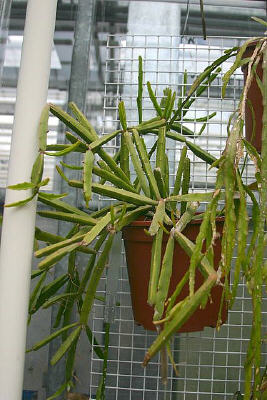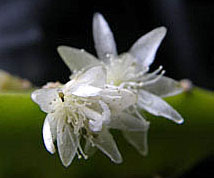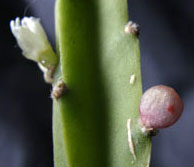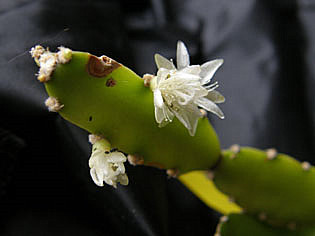|




Top: R. cereoides
(copyright KAF, Kew 2006) All others copyright KAF 2007
Previous Page
|
Lithophyte in open habitat, rarely epiphyte, 30-100 cm long, branching apical. Stem segments triangular to quadrangular in longitudinal section, rarely pentagonal, 2-5 mm diam, olive green with reddish margin, succulent, stiff, monomorphic, 6-12 cm long, base attenuate, apex truncate, wings 3-4(-5), 0.7-1 cm wide, margin entire to slightly crenate, straight, with 0-1 (-3) mm projections, midrib ca. 6 mm diam, with shape not evidently marked (hidden by stem succulence). Areoles between margin projections, 1-1.5 cm apart, first of segment 1-1.5 cm distant from segment base; when sterile 2 mm diam, pilose sometimes with vestigial scales; when fertile 2.5-3 mm diam, pilose with numerous acicular scales, some spine-like, 1-3 flowers/fruits. Flowers ca. 15 mm diam; pericarpel 3.5-4 X 3.5 mm, obovoid, greenish, sometimes reddish, glabrous or with sepaloid bract near apex; with 1-4 sepaloid tepals, 1.5-3.5 mm long and 8-10 petaloid tepals, 4.5-9 X 2.5-4 mm, oblong to elliptic, patent, whitish, apex rounded, acute or mucronate, cucullate, margin straight or curved inwards. Style ca. 5 mm long; stigma with 4-6 lobes, 1.5-2.5 mm long, ligulate, curved, sub-reflexed. Ovules in 3-4 rows, funicle short (< 0.5 mm long). Stamens ca. 50, 2-5.5 mm long, internal shorter, spreading, white. Nectary ca. 0.6 mm long. Fruit 5.5 X 5 mm, globoid, pinkish or whitish, glabrous. Figure 2: B, F.
Notes: Rhipsalis cereoides is a well-circumscribed species, easily identified by the stem segments with narrow succulent wings and almost straight margin. The only other species that shares the same habitat type (open and sunny coastal inselbergs of Rio de Janeiro and Niteroi) is Rhipsalis triangularis. However, R. triangularis occurs further south in Rio de Janeiro.
Habitat and distribution: Occurs in open and sunny inselbergs in Rio de Janeiro and Niteroi (Rio de Janeiro, Brazil). Figure 3.
Rhipsalis cereoides (Backeberg & Voll) Backeberg. Kakteen Pflanzen Samen 1927-1937, 10 Jahre Kakteen forschung [catalogue]; 39 (1937-38)
Desc from Backeberg 1977 |
- Body - with greater or lesser development of aerial roots at the nodes and then resembling small Hylocerei.
- Shoots - acutely 3-angled. rarely 4-sided, 4 - l0 cm long., to 1.7 cm thick, the angles often offset on successive segments.
- Areoles - small, scales minute, with traces of felt, with 2 - 4 short weak branches.
- Flowers - to 3 - 4 at one time, c. 2 cm Æ. white, spreading,
- Petals - convex:
- Fruit - spherical, olive-green at first. then transparent light pink;
- Seed - glossy. dark brown, numerous.
- Type locality - Brazil (around Rio de Janeiro).
DISTRIBUTION - Brazil (S Espirito Santo, S Rio de Janeiro); epilithic on gneissic inselbergs, near sea level to 900 m altitude.
Note from Bradleya 13
A specimen apparently intermediate between this species and R. pachyptera has been observed ( Castellanos 23146, GUA!)
Desc from Hunt 2006
Branch segments 3-4 angled, 4-10cm x up to 17mm, not crenate; areoles not sunken, sometimes with 2-4 very short bristles; flowers solitary or 2-4 per areole, rotate, 2cm diam., white; fruit pale pink |



